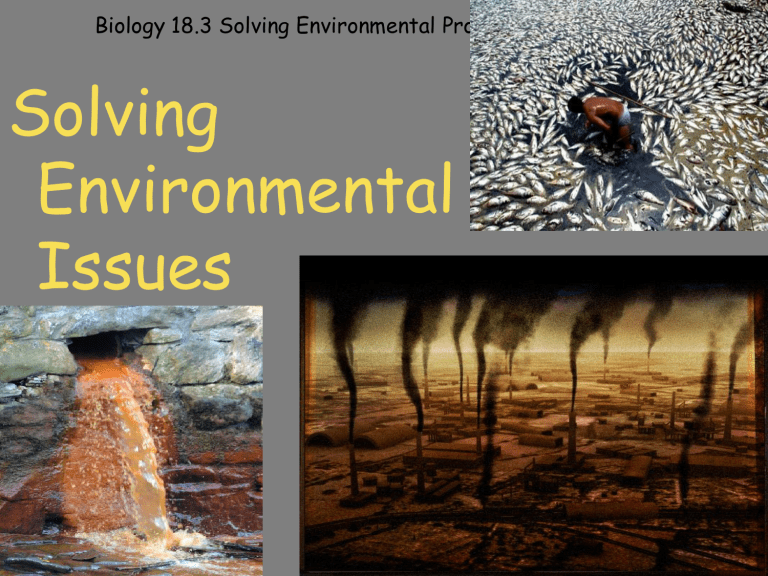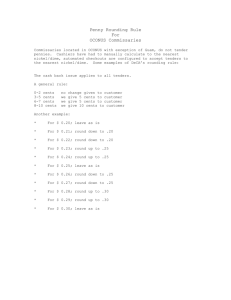File

Biology 18.3 Solving Environmental Problems
Solving
Environmental
Issues
1/7/2010
Solving Environmental Problems: A Worldwide Effort
As you have seen, environmental problems affect all inhabitants of an ecosystem without regard to state or national boundaries.
As human activities continue to place severe stresses on ecosystems, worldwide attention must be focused on solving these problems.
One of the most important developments of the 1990s was the global increase in efforts to reduce pollution . International agreements to stop CFC production is one example of a step forward.
1/7/2010
Solving Environmental Problems: A Worldwide Effort
In addition to stopping CFC production, the use and production of many dangerous industrial chemicals have been restricted in the United States.
DDT and carcinogenic (cancer causing) substances such as asbestos and dioxins have been restricted in the
United States and laws have been enforced to remove these materials from public environments.
Asbestos
1/7/2010
Solving Environmental Problems: A Worldwide Effort
The number of secondary sewage treatment plants, which remove chemicals as well as bacteria from sewage, is on the increase.
Scrubbers , a device that removes harmful sulfur emissions from industrial smokestacks, are now in mandatory use in many states.
Emissions of sulfur dioxide, carbon monoxide, and soot ( 3 pollutants that come from burning coal) have been cut by more than 30% in the past 10 years.
Smokestack with scrubber system
Model of scrub system
1/7/2010
Solving Environmental Problems: A Worldwide Effort
However encouraging these developments are, this progress represents only the beginning of what needs to be done.
Serious attempts to address the overall problem of pollution have brought about fundamental changes in our society.
For example, dedicated carpool lanes on urban highways encourage city commuters to pool together to lower the amount of traffic, and thus pollution, in cities such as Boston
1/7/2010
Solving Environmental Problems: A Worldwide Effort
Efforts in the United States:
Two effective approaches have been taken to reduce pollution in the United
States.
The first approach has been to pass laws forbidding it.
In the last 30 years, laws have begun to significantly slow the spread of pollution. These laws impose strict standards for what can be released into the environment.
For example, all automobiles are now required to have catalytic convertors to reduce emissions.
1/7/2010
Solving Environmental Problems: A Worldwide Effort
A second effective approach to reducing pollution is to make it more expensive by placing a tax on it. The gasoline tax is an example of such a tax.
To be fully effective, the tax must be high enough to reflect the actual cost of the pollution.
By adjusting the tax, the government attempts to balance the conflicting demands of environmental safety with economic growth.
Such taxes, often imposed on industry in the form of “pollution permits”, are becoming increasingly common.
Gasoline Tax
1921-Enacted at 1 cent per gallon
1924-Increased to 2 cents
1929-Increased to 3 cents
1931-Increased to 4 cents
1933-Increased to 5 cents
1949-Increased to 6.5 cents
1961-Increased to 7.5 cents
1967-Increased to 9 cents
1977-Increased to 11 cents
1979-Increased to 12 cents
1981-Increased to 13.5 cents
1982-Decreased to 12 cents
1983-Increased to 16 cents
1984-Increased to 18 cents
1990-Increased to 22 cents
1991-Increased to 23 cents
2003-Increased to 28 cents
2005-Increased to 31 cents
2006-Increased to 34 cents
2007-Increased to 36 cents
2008-Increased to 37.5 cents
Solving Environmental Problems: A Worldwide Effort
S olving Environmental Problems:
Five Steps to Success: Viewed simply, there are five components to successfully solving any environmental problem.
1: Assessment: Do a scientific analysis of the problem, gather information. Build a model of the ecosystem by collecting and analyzing data. This model will allow scientists to make predictions about the future of an ecosystem.
2: Risk Analysis: Using the information obtained from the scientific data collection and analysis, scientists than predict the consequences of different types of environmental intervention. It is important to identify and evaluate any negative affects a plan may have as well at this stage. Weigh the advantages against the disadvantages of a plan.
1/7/2010
Solving Environmental Problems: A Worldwide Effort
S olving Environmental Problems: Five Steps to Success:
3: Public Education: When it is possible to describe alternative courses of action, the public must be informed. This involves
explaining the problem to the public in understandable terms,
presenting any alternative actions available,
and explaining the costs involved in paying for each these actions.
4: Political Action: The public, through it’s elected officials, selects and implements a course of action. Individuals and grassroots organizations can be very influential at this stage with their own votes and their ability to get others to come out and vote on issues.
5: Follow-through: The results of any action should be carefully monitored to see if the environmental problem is being solved.
1/7/2010
Solving Environmental Problems: A Worldwide Effort
Solving Environmental Problems:
The development of appropriate solutions to the world’s environmental problems often rests partly on the shoulders of politicians, economists, bankers, scientists, and engineers.
However it is important to not lose sight of the importance of informed individuals like yourself.
“Never doubt that a small group of thoughtful, committed citizens can change the world; indeed, it's the only thing that ever has.” Margaret Mead quote
1/7/2010
Solving Environmental Problems: A Worldwide Effort
The Nashua River: example
Running through the heart of New
England, the Nashua River was severely polluted by mills established in
Massachusetts in the early 1900s.
When Marion Stoddard moved to town along the river in 1962, she was shocked at the pollution. Stoddart organized the Nashua River Clean-Up
Committee.
The Committee presented bottles of dirty river water to politicians, spoke at town meetings, and began to clean garbage up from along Nashua River’s banks.
Solving Environmental Problems: A Worldwide Effort
The Nashua River: example
This campaign contributed to the passage of the Massachusetts Clean
Water Act of 1966 which mandated new pollution laws in the state.
Industrial dumping into the river is now banned, and the river has largely recovered.
Mid-60s
Today
1/7/2010
Solving Environmental Problems: A Worldwide Effort
Lake Washington:
Following World War II, this very large lake east of Seattle became surrounded by a ring of ten suburbs, each with it’s own sewage treatment plant.
Between 1940 and 1953, these ten municipal plants discharged their treated outflow into the lake.
Safe-enough to drink, the treated outflow was thought to be harmless.
Starting in the early 1940s, the combined daily discharge was 20 million gallons.
1/7/2010
Solving Environmental Problems: A Worldwide Effort
Lake Washington:
In 1954, scientists noted that bluegreen algae was being reported growing in the land in increasing amounts.
This algae required large amounts of nutrients nitrogen and phosphorous to grow. Because deep freshwater lakes like Lake Washington usually lack these nutrients, it was a surprising find.
Researchers discovered that phosphates and nitrates in the waste water was fertilizing the lake making the algae grow rapidly.
1/7/2010
Algae bloom
Solving Environmental Problems: A Worldwide Effort
Lake Washington:
Seattle ecology professor WT
Edmonson became alarmed about this and began a campaign to educate the public and public officials about the danger that came with this.
If this practice kept up, the lake would fill up with algae and rob the lake of it’s oxygen.
This depletion of oxygen would kill all life in the lake, with little or no chance of recovery in the future.
1/7/2010
Algae bloom
Solving Environmental Problems: A Worldwide Effort
Lake Washington:
After 5 years, as a direct result of
Edmonson’s efforts, joint municipal taxes financed the cleanup of Lake
Washington. Today a massive trunk sewer that rings the lake and carries treated discharge far out into Puget
Sound.
Today, through the efforts of many people, the lake is healthy with waters clean and blue.
Lake Washington today
1/7/2010
Solving Environmental Problems: A Worldwide Effort
Many artists today as well create works that draw attention to ecology and environmental issues.
Seattle artist Buster Simpson has created works for years which involve dropping ceramic discs, River Rolaids, into rivers by factories.
These ceramic discs are left at the mouth of the discharge pipes where factories were illegally dumping chemicals at night.
Among Simpson’s best known projects is Hudson River
Purge. This installation in New York is part of a continuing series, dating back to 1983. Simpson placed soft limestone disks in the headwaters of the Hudson River (part of the
New York City water supply). The limestone sculpture is a populist environmental agit prop, working both metaphorically and pharmaceutically. As a metaphor, it dramatizes the crisis of person and planet as one: acid indigestion, acid rain – a connection the media picked up on when the coined the titles “River Rolaids” and “Tums for
Mother Nature.”
1/7/2010
Solving Environmental Problems: A Worldwide Effort
Simpson put a net across the river downstream from the ceramic platters he had left.
The river’s flow carried them to the net eventually where he recovered them.
At this point, the ceramic Rolaids discs were covered with chemical residue from the toxic wastes they had been left in.
When Simpson heated the discs in a kiln, the toxic materials became bright colored glazes; the brighter the glaze the more toxic the chemicals it had been left in.
Among Simpson’s best known projects is Hudson River
Purge. This installation in New York is part of a continuing series, dating back to 1983. Simpson placed soft limestone disks in the headwaters of the Hudson River (part of the
New York City water supply). The limestone sculpture is a populist environmental agit prop, working both metaphorically and pharmaceutically. As a metaphor, it dramatizes the crisis of person and planet as one: acid indigestion, acid rain – a connection the media picked up on when the coined the titles “River Rolaids” and “Tums for
Mother Nature.”
Solving Environmental Problems: A Worldwide Effort
The bright colors from the toxic glazes revealed which factories had been dumping illegally at night which chemicals.
Once Simpson’s Rolaids were displayed at a gallery, complete with a map of where they had been left and what chemicals they had been coated in by the pollution , the press got a hold of the information.
After that it was only a short period of time before the data revealed by
Simpson’s art piece shut down all the illegal dumping operations that were going on with these factories.
Among Simpson’s best known projects is Hudson River
Purge. This installation in New York is part of a continuing series, dating back to 1983. Simpson placed soft limestone disks in the headwaters of the Hudson
River (part of the New York City water supply). The limestone sculpture is a populist environmental agit prop,
In this way, an artist’s statement about the environment made an actual affect on working both metaphorically and pharmaceutically. As a metaphor, it dramatizes the crisis of person and planet as one: acid indigestion, acid rain – a connection the media picked up on when the coined the titles “River Rolaids” the environment by informing the public and triggering action by the authorities.
The River Rolaids cleaned up Mother
Nature’s indigestion.
and “Tums for Mother Nature.”
1/7/2010
Solving Environmental Problems: A Worldwide Effort
YOUR CONTRIBUTION:
It has been said that we do not inherit the Earth from our parents but borrow it from our children. We must preserve for future generations what we ourselves today enjoy.
While solving the world’s environmental problems can involve many people, ranging from artists and engineers to politicians and activists, the major issues are not scientific or biological.
We, as a society, need to learn to all do our part so, as a whole, we can reduce energy usage and conserve the resources we currently have.
1/7/2010
Lake Washington today
Solving Environmental Problems: A Worldwide Effort
Today, all of us can do our part by recycling, conserving energy, creating less waste, and working together as a community to realize and solve our problems before they get too serious to deal with.
Here are some ways that we all can participate in helping save our environment
Walk or ride a bike
Use public transportation
Recycle your newspaper, cardboard, plastics, etc.
Compost food wastes at home
Install low-energy bulbs in your
1/7/2010 home
Shutoff computers when not in use
Install low-flow shower heads at home or use low flow toilets
Energy efficient bulb recycling
1/7/2010





